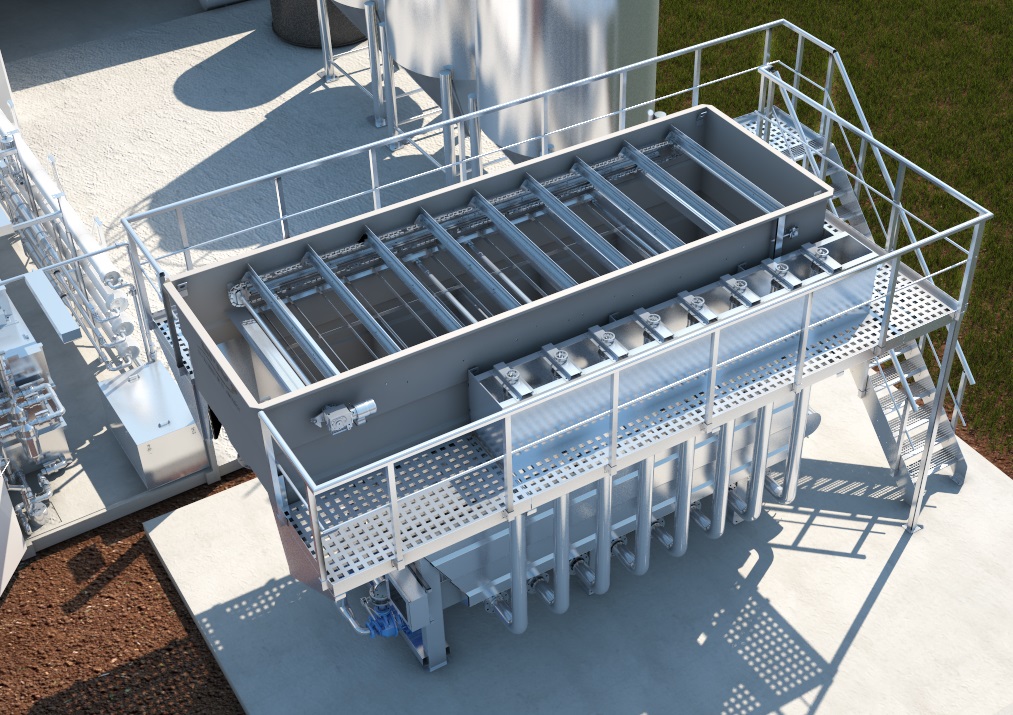Dissolved Air Flotation units
Dissolved Air Flotation (DAF) is a separation technique whereby the adherence of micro air bubbles to suspended pollutants in water is used to enhance separation efficiency. DAF is applied when the density of the suspended pollutants is close to that of the water so that gravity separation becomes very difficult.

Micro bubble formation
Micro bubbles can be generated by dissolving air in pressurized water and de-pressurizing this water. In the DAF units, designed by Spaans Babcock Technology, this process is effected in a recirculation system. Part of the treated water is recycled to the feed via a special centrifugal pump. Air is added to this recycle stream at pressure site of the pump. The air will dissolve in the water by using special mixing zones.
The air saturated water is introduced into the DAF unit feed line and inlet points at the bottom of the unit.
DAF systems are used in for example:
Many companies use standardised DAF systems. SBT designs and builds unique and tailor made units for each specific situation, based on flows and loading so you only pay for what you need.
SBT developed systems based on years of experience with unique parts in or at the units. The unique parts are:
-Special circulation system for creating micro bubbles.
-Waste water inlet system. Important for optimal use of the content of the unit.
-Integrated sludge thickener on top of unit. To achieve as high as possible solids content and minimize sludge volume.
-Shaftless auger at bottom. To transport and minimize volume settled sludge.

Biological treatment is an important and integral part of any wastewater treatment plant that treats soluble organic impurities or a mix of wastewater sources[1] .
Biological treatment using an aerobic activated sludge process has been in practice for well over a century. Increasing pressure to meet more stringent discharge standards or not being allowed to discharge treated effluent has led to implementation of a variety of advanced biological treatment processes in recent years.
Aerobic means in the presence of air (oxygen). Therefore, aerobic treatment processes take place in the presence of air and utilize those microorganisms (also called aerobes), which use molecular/free oxygen to assimilate organic impurities i.e. convert them in to carbon dioxide, water and biomass.
SBT designs various types of biological systems. Depending on the type of wastewater, location, and effluent demands, the best solution will be designed. In general an SBR (Sequencing Batch Reactor), FBR (Flotation Bio Rreactor), MBR (Membrane Bio Reactor) or a continuous biological system will be advised.
This would include industrial, municipal, and combined sewer.
Advantages
Biological treatment is an important and integral part of any wastewater treatment plant that treats soluble organic impurities or a mix of wastewater sources[1] .
Biological treatment using an aerobic activated sludge process has been in practice for well over a century. Increasing pressure to meet more stringent discharge standards or not being allowed to discharge treated effluent has led to implementation of a variety of advanced biological treatment processes in recent years.
Aerobic means in the presence of air (oxygen). Therefore, aerobic treatment processes take place in the presence of air and utilize those microorganisms (also called aerobes), which use molecular/free oxygen to assimilate organic impurities i.e. convert them in to carbon dioxide, water and biomass.
SBT designs various types of biological systems. Depending on the type of wastewater, location, and effluent demands, the best solution will be designed. In general an SBR (Sequencing Batch Reactor), FBR (Flotation Bio Rreactor), MBR (Membrane Bio Reactor) or a continuous biological system will be advised.
This would include industrial, municipal, and combined sewer.

